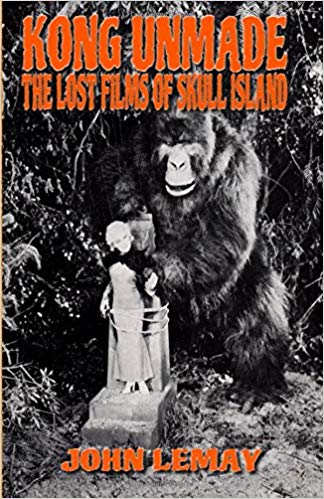
Tokusatsu film historian John LeMay has done it again! After indexing every kaiju (giant monster) movie from the 1950s to today with The Big Book of Japanese Giant Monster Movies, Vol. 1-2, his newest is essentially the third entry in what could be called his Lost Films trilogy. Previously he discovered unused scripts and story treatments for famous Japanese monsters like Godzilla and Gamera with the copiously-researched The Big Book of Japanese Giant Monster Movies: The Lost Films and more down-to-size Japanese science fiction and fantasy films with Terror of the Lost Tokusatsu Films. Now he brings readers the “lost films” of the granddaddy of all kaiju, King Kong, with Kong Unmade: The Lost Films of Skull Island.
While Kong’s impact on pop culture is humungous, his filmography is surprisingly short. In all, he has only ten official films (plus one upcoming movie) in over eight-and-a-half decades. It’s not from a lack of trying, though, as LeMay details. Director/producer Merrian C. Cooper tried for years to make another sequel to the 1933 classic after the hastily-made Son of Kong. The New Adventures of King Kong would’ve been a “midquel” that took place while Kong was being transported from Skull Island to New York, where he escaped into the jungles of Africa. A similar and even more outlandish idea was Tarzan vs. King Kong, where the big ape would’ve met the famous ape man. On the other side of the Pacific, Toho Studios attempted to create Frankenstein vs. King Kong, which eventually became King Kong vs. Godzilla. After its massive success, a script for a rematch—cleverly titled Continuation: King Kong vs. Godzilla—was written that would’ve had Kong become a surrogate father to a lost infant. And that’s just a few examples!
Essays on these lost films aren’t all that’s in this new volume. There are “bonus reviews” and “development of” chapters on the Kong films that did get made. They detail many concepts that were abandoned or changed during the filmmaking process. For example, the script Peter Jackson wrote for his 2005 remake was originally quite different (Ann Darrow was British, for one thing). There are also essays on lost or obscure Kong media such as Don Glut’s Tor films and what would’ve been an animated sequel to King Kong Lives featuring Kong’s son (who would’ve had the ability to change his size) by producer/artist Robert Lamb. Several of these essays are written by excellent guest contributors. LeMay also writes on obscure and lost films that were inspired by King Kong, such as The Mighty Gorga and the infamous A*P*E*. If they don’t get a full-length chapter, they’re included in one of the book’s several appendices.
One improvement over LeMay’s previous books is the inclusion of many images. These are photographs, movie posters, and concept art. The aforementioned chapter on the proposed Kong animated series includes concept art from Lamb, which gave me flashbacks to the Saturday morning cartoons of my childhood. A downside of the images is some of them are placed on right-hand pages opposite from the previous essay, and since these don’t have captions, it isn’t apparent that they’re meant to signal the next essay.
As usual, the design of the book is creative. The spine is designed to look like it has a library index code taped onto it. The title pages have a few ink splotches to simulate age and a half-faded stamp that says, “This book has been discarded by the Skull Island Public Library.” They’re wonderful touches, and the sort of clever design choices I wish I saw more often in books.
If I may mention a fairly significant nitpick, there are points I think the book could’ve been edited and proofread a bit better, but this is coming from someone who spends a lot of time editing in his work, so it’s hard for me to miss.
For fans of Kong, kaiju, film history, and/or LeMay, this is a must-read!
Five Stars out of Five.
